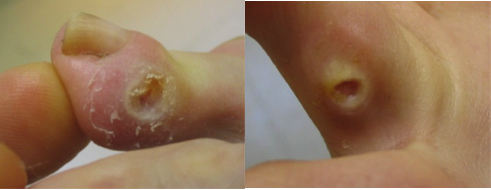1. What is a corn?
“Corn” is also known as “heloma” in a medical term which describes thick areas of skin that develop as a result of an excessive amount of pressure and friction being applied to the skin. Corns, rather than being a defect, are our body’s protective mechanism from further damage. There are types of corn that develop; hard corns known as heloma durum and soft corns known as heloma molle.
2. What causes painful corns?
Corns can be caused by a number of reasons;
- Enlarged joint
- Wearing tight/pointed shoes
- Adductovarus deformity of the toe: a crooked toe that moves under the adjacent toe
3. Conservative Treatments
Non-operational treatments: aims to reduce excessive pressure.
- Regular podiatry visit: Podiatrists can reduce the painful corn by debridement and manufacture custom-made toe separator to reduce excessive pressure
- Avoid wearing tight/pointed shoes
- Do not use a corn pad as it contains salicylic-acids and when applied improperly, these corn pads can create a chemical burn in healthy tissue that may result in infections and ulcers.
4. Surgical Treatment
Surgery aims to remove enlarge joint (arthroplasty) and surgery is relatively simple with a small incision over the toe.
- Do I need surgery?
Whether you have surgery or not is purely your choice. Surgery is usually recommended if conservative treatments have failed to provide good relief.
- What does the surgery involve?
Surgery for painful interditial corn is a relatively quick and easy surgery. It usually involves:
- A small incision(around 2 cm) over the toe
- Removal of the condyle (head part of phalanx)
- Repair of tendon, capsule and skin closure
- If there is a tight tendon or contracted skin, tenotomy or lengthening of tendon or skin plasty are performed to address these problems
- Anaesthetics: Various anaesthetics are available (General or spinal block or local anaesthetics with sedation)
5. After the surgery
- Keep your foot elevated as much as possible and apply an ice pack for the first week following surgery
- Your dressing will be changed between 3-7 days at the office after surgery
- Keep your dressing dry for the first 2 weeks after surgery
- Sutures will be removed between 2-3 weeks after surgery
- You are able to weight-bear on the heel in the postop surgical shoe
- You need expect to wear postop surgical shoes for 1-2 weeks








 Mad Hat Media
Mad Hat Media